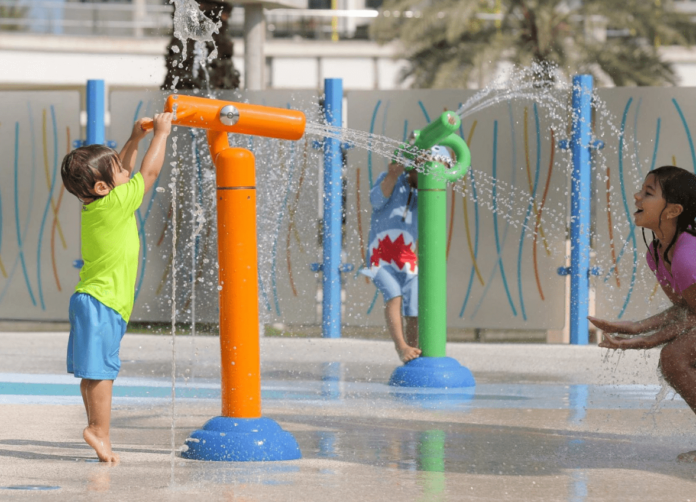Because they offer engaging, entertaining water play in a safe and eco-friendly manner, splash pads have grown in popularity as a feature in parks, leisure areas, and even private homes. Splash pads, as opposed to typical swimming pools, provide a water play experience without the requirement for standing water, making them simpler to maintain and safer for kids. An effective splash pad is made up of carefully thought-out parts that work together to create a whole experience. We will examine all the important parts of a components of a splash pad in detail in this post, from the underlying infrastructure to the water features.
Table of Contents
Water Features
The central attraction of each components of a splash pad is its water feature. Their many designs, sizes, and functionalities offer users a dynamic and engaging experience. Children may have a range of sensory experiences with the splash pad’s assortment of water features, which makes it entertaining and engaging. The following are a few typical kinds of water features:
- Water jets that shoot up from the ground in a variety of patterns and intensities are known as ground sprays. Ground sprays provide a fun surprise as they randomly or in predetermined patterns splash up. They can be made to be milder for toddlers or more powerful for older kids.
- Water Cannons: These interactive features let users adjust the water’s flow and direction. It’s an extremely interactive aspect that adds a challenge and fun factor. Kids may aim and spray water at targets or their friends.
- Dump Buckets: Frequently regarded as one of the most thrilling elements on a splash pad, dump buckets submerge everyone below when they fill with water and topple over at a specific weight. Excitement is added by the anticipation of waiting for the bucket to topple.
- Kids can run through water streams that cascade or a soft mist created by these misting arches and water tunnels. In hotter regions, misting arches are particularly well-liked because they offer a cooling effect and let kids play with water in a gentle way.
- Water Tables and Channels: These features, which are frequently seen at splash parks for younger kids, let kids engage with water on a smaller scale. With their ability to control water flow, teach about movement, and experiment with various textures, they provide entertainment and educational value.
- Waterfalls with Spray Nozzles: To fire horizontal streams of water, spray nozzles can be fixed to walls or poles. A distinct experience from ground sprays and jets, waterfalls create a curtain of water for kids to run under.
Surface Materials
A splash pad’s surface is essential to both operation and safety. Splash pads allow kids to run and play on damp surfaces, so picking the proper material is crucial to avoiding trips and falls. Drainage capacities, durability, and non-slip textures are important factors to take into account. Typical surface substances consist of:
- Concrete with Anti-Slip Coating: Because concrete is so durable, it’s frequently used as the foundation material for splash pads. However, the surface is usually coated with an anti-slip substance that offers traction even in rainy conditions in order to make it safe. To improve grip, textured coatings can also be used.
- Rubberized Surfaces: For components of a splash pad meant for smaller children, rubberized surfaces are typically used as they offer a softer landing. They lower the risk of injury from falls by providing superior slide resistance and being kinder to the feet and knees.
- Permeable Surfaces: A few components of a splash pad have surfaces that let water pass through them rapidly. This lessens the chance of slick spots forming and helps avoid pooling.
Water Distribution and Recirculation System
An essential part of the components of a splash pad is the water distribution system, which makes sure that water flows to the different elements in an economical and sustainable way. The majority of splash pads employ either a fresh-water system or a recirculating system because they were developed with water conservation in mind.
- Fresh-Water Systems: In this configuration, water is sprayed onto the components of a splash pad directly from a municipal source, and it subsequently drains away—typically into the ground or a neighboring drainage system. Although this technique is straightforward, it consumes more water, therefore it might not be the best choice in areas with expensive water bills.
- Recirculating Systems: Though more intricate, these systems are better for the environment. The components of a splash pad collects water, which is then collected in an underground reservoir, treated, filtered, and then pumped back through the system. Recirculating systems provide a sustainable operation while drastically reducing water use. In order to preserve water quality and stop the spread of bacteria, these systems must have adequate filtration and treatment.
Water Treatment System
A strong water treatment system is essential for components of a splash pad that use recirculating water systems in order to maintain the water’s cleanliness and user safety. Usually, this system consists of:
- Filtration Units: Prior to the water being pumped again, these units filter out particles, dirt, and leaves. In splash pads, sand and cartridge filters are frequently used to guarantee pure water.
- Chemical Treatment: To eradicate germs and other dangerous organisms, water needs to be treated with chemicals like chlorine. By monitoring pH levels and adding the appropriate amount of treatment agents, automated chemical dispensers contribute to the maintenance of consistent water quality.
- UV Disinfection: UV light systems are another method used by certain splash pads to sanitize the water. For environmentally aware components of a splash pad, UV disinfection is a popular choice because it effectively neutralizes germs and viruses without the need for extra chemicals.
Drainage System
To keep the splash pad dry and avoid standing water, which could pose a safety risk, an efficient drainage system is necessary. An integrated drainage system in most components of a splash pad directs water away from the surface as soon as it touches it. This keeps water from pooling, which could cause slips and falls or encourage the growth of bacteria or algae. It also helps prevent flooding.
Usually, splash pads employ one of two primary drainage system types:
Water naturally flows to lower places due to gravity drainage, where it is gathered in drains and sent away from the splash pad. If the components of a splash pad is made with the right slope to allow water to flow through it, this device is easy to use and rather effective.
Pumped Drainage: Pumped drainage systems actively transfer water from the surface to the drainage area or reservoir when gravity drainage is not practical. Although these systems need more upkeep, they work well in small or level areas.
Control System
The timing, flow, and functionality of a components of a splash pad different water elements are controlled by the control system. This is accomplished in the majority of contemporary components of a splash pad via an electronic control panel that can be set to regulate the length of sprays, change the water pressure, and operate water features in cycles.
Certain components of a splash pad have interactive features that allow users to control the water features, like push-button activation systems. In addition to saving water, this gives kids more excitement because they can customize their play space.
Safety and Accessibility Features
Safety and accessibility are the first priorities in any well-designed splash pad. Non-slip surfaces, adequate water filtration, and clear drainage systems to prevent water pooling are examples of safety features. Splash pads should also be made with accessibility in mind so that kids of all skill levels can have fun with the water. A components of a splash pad can be made more inclusive by adding elements like tactile textures, moderate slopes, and mild water sprays.
Conclusion
Together, the parts of a splash pad provide a secure, entertaining, and stimulating setting for water play. Every component, from the crucial infrastructure like the water distribution, treatment, and drainage systems to the water features like jets, cannons, and dump buckets, is essential to providing a well-rounded experience. components of a splash pad are a popular fixture in both public and private places because of its excellent utility, which is further enhanced by their selection of materials, safety features, and control systems.



